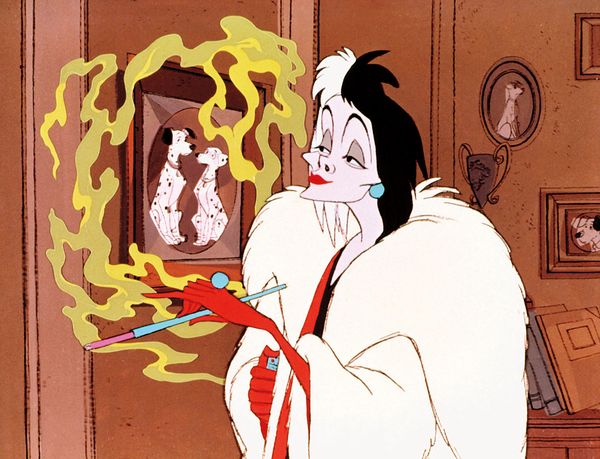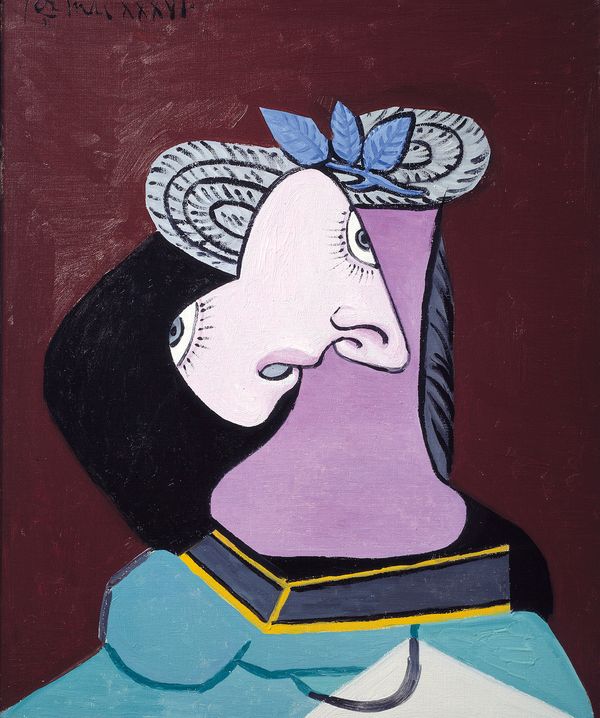Keith Haring Cruella de Vil, 1984
Known for painting radiant cartoon figures roaming freely across variable surfaces, Keith Haring built an inimitable oeuvre that is today considered as important in the canon of contemporary art as it is in mainstream culture. Executed in 1984, Cruella de Vil is a captivating example from the artist's body of work. Portraying the infamous villain from Walt Disney's 101 Dalmatians – here caught in the malignant act of burning a puppy's fur with her cigarette butt – Haring delves into the realm of popular culture while retaining a style that is distinctly his, operating at a crossroads between vigorous, graffiti mark-making and the jagged angles of Pablo Picasso's Cubism. Coming at a critical point in the artist's career, Cruella de Vil marks the first time Haring addressed Walt Disney's creations in his painterly opus. It is a further testament to the work's significance that it was formerly owned by Princess Gloria von Thurn und Taxis, a prominent collector and artist in her own right.
The basis of Haring's art was always the drawn line. Beginning to practice his draughtsmanship as a child around the kitchen table, Haring continued cultivating his artistic proclivity during his studies at Pittsburgh's Ivy School of Professional Art. There, he came across the work of Pierre Alechinsky, Jean Dubuffet and Fernand Léger. Inspired by their spontaneity of gesture and unrepressed use of color, Haring further honed his free-flowing line, materialized in his vibrant subway drawings of the late 1970s and early 1980s. Concerned with the relevance of his imagery, he perpetually pushed contemporaneous art historical discourse into forward-looking trends that echoed the world around him. "Living in 1984, the role of the artist has to be different from what it was fifty, or even twenty years ago," he declared. "I am continually amazed at the number of artists who continue working as if the camera were never invented, as if Andy Warhol never existed, as if airplanes and computers and videotape were never heard of" (Keith Haring, quoted in 'Untitled Statement' , Flash Art). In 1984, he thus produced the present Cruella de Vil, and the following year, he realized his iconic Andy Mouse character in painting for the first time, conflating Walt Disney's infamous Mickey and the facial features of his friend and fellow artist Andy Warhol.
Disney's genius for making imagery that was comprehensible to a huge international cross-section of people served as a role model to Haring. — Bruce D. Kurtz, 'Haring, Warhol, Disney'
Wearing the fur of innocent puppies with unrepressed pride, Cruella owns her name as she would a motto. While Haring ceaselessly attempts to reveal dark truths in friendly guises – typically through the use of his own cartoon figures, dancing with dynamic and sexual fervor, here, he employs a subject whose cruelty is paired with real-life socio-political tendencies: exploitation, materialism and greed, while adopting a deceitful veneer of sophistication. Unlike other Disney villains, Cruella is physically and capitalistically savvy: she speaks in the modern world's terms of brutality and savagery, benefitting from the suffering of others while showing no sign of guilt or compassion. Departing from the innocent figure of Mickey, who seemed more a wistful nod to Warhol's Pop compositions, Cruella is here imparted with the meaning of Haring's more mature work, as his oeuvre began to reflect the tragedies that fell upon New York's social landscape in the 1980s.
Film still from Walt Disney's 101 Dalmations, 1961. Image: Bridgeman Images.
Within the art historical canon, two painters who had a profound effect on Haring were Pablo Picasso and Andy Warhol. On the one hand, Picasso allowed himself complete liberty of form in the act of representation; on the other, Warhol introduced the primacy of replication and appropriation in a world where imagery continuously proliferated. In Cruella, her fragmented facial features bear an uncanny resemblance to those of Dora Maar, and her mean gesture, rendered with playfully vibrant hues, presents a commodification of violence akin to Warhol's Disaster silkscreens. As a result, the painting brims with Haring's multifarious visual references, adroitly mixing aspects of high and low art.
Pablo Picasso Le Chapeau de paille au feuillage bleu, 1936, oil on canvas, Musée Picasso, Paris. © Succession Picasso/DACS, London 2019.
As powerful as its subject matter, the formal qualities of this painting from our London 20th Century & Contemporary Art Evening Sale demonstrate Haring's need to remain anchored in popular culture, fed by the charismatic presence of the seminal cartoon figures that he had looked up to since his childhood. "I consider myself a perfect product of the space age not only because I was born in the year that the first man was launched into space, but also because I grew up with Walt Disney cartoons," he once exclaimed. Being the product of TV culture near its genesis, Haring grew up surrounded by these characters, and only naturally began including them in his art. He subsequently merged these with iconic styles culled from art history, as well as symbols or signifiers salvaged from the urban landscape of New York City.


